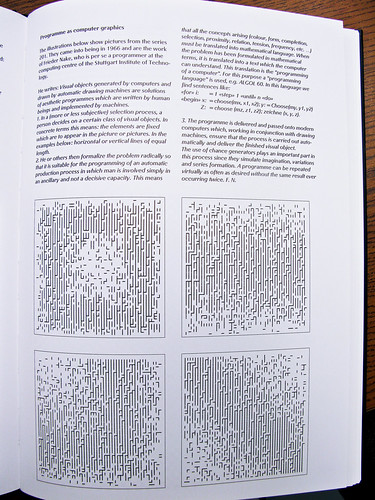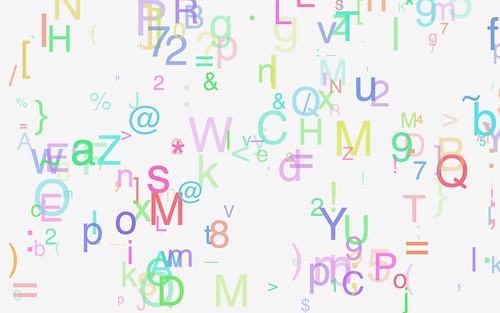Akron 396 Karl Gerstner - Programme as computer graphics
Image by watz
"Designing Programmes", classic book on form as programme by the Swiss designer Karl Gerstner.
Page 21: Programme as computer graphics
The illustrations below show pictures from the series 201. They came into being in 1966 and are the work of Frieder Nake, who is per se a programmer at the computing centre of the Stuttgart Institute of Technonlogy.
He writes: Visual objects generated by computers and by automatic drawing machines are solutions of aesthetic programmes which are written by human beings and implemented by machines.
1. In a (more or less subjective) selection process, a person decides on a certain class of visual objects. In concrete terms this means: the elements are fixed which are to appear in the picture or pictures. In the examples below: horizontal or vertical lines of equal length.
2. He or others then formalize the problem radically so that it is suitable for the programming of an automatic production process in which man is involved simply in an ancillary and not a decisive capacity. This means that all the concepts arising (colour, form, completion, selection, proximity, relation, tension, frequency, etc...)
must be translated into mathematical language. When the problem has been formulated in mathematical terms, it is translated into a text which the computer can understand. This translation is the "Programming of a computer". For this purpose a "programming language" is used e.g. ALGOL 60. In this language we find sentences like:
«for» i:=1 «step» 1 «until» n «do»
«begin» x:=choose(mx,x1,x2); y:=choose(my, y1, y2)
z: =choose(mz, z1, z2); zeichne (x, y, z).
3. The programme is delivered and passed onto modern computers which, working in conjunction with drawing machines, ensure that the process is carried out automatically and deliver the finished visual object.
The use of chance generators plays an important part in this process since they simulate imagination, variations and series formation. A programme can be repeated virtually as often as desired without the same result ever
occurring twice. F. N.
Honors Newsletter Banner
Image by Edith OSB
Well, I'm pleased as punch. I took a class in Computer Graphic Design with an eye towards gaining some graphic skills that could be helpful for teaching and working on the web. I've learned an awful lot - but found myself doing bizarre things like creating a scene where the Mars Rover is landing in front of a McDonald's on Mars: creative, but I'm not sure where I'll use it.
The Final Project was open-ended, so I decided to see if I could design a banner for our brand-new Honors Program newsletter. My goal: create something where the title and logo would be constant, the issue date could be updated - but the photo could easily be changed so that each issue would have a fresh look. It would be a plus if I could put in on the Honors Program web pages too.
This is one of the three models I turned in. I'll spare you the details of textured and beveled typefaces, or reversed drop-shadows. I've learned that there is a lot more to most of the well-designed things I enjoy, and it's fun to be able to do a bit of that sort of thing myself.
Processing Experiments
Image by Rich_Lem
Wellsford, New Zealand, December 2010
These are my first, fumbling steps in Processing. None of this stuff is particularly good or interesting, but I'm learning as I go.
No comments:
Post a Comment